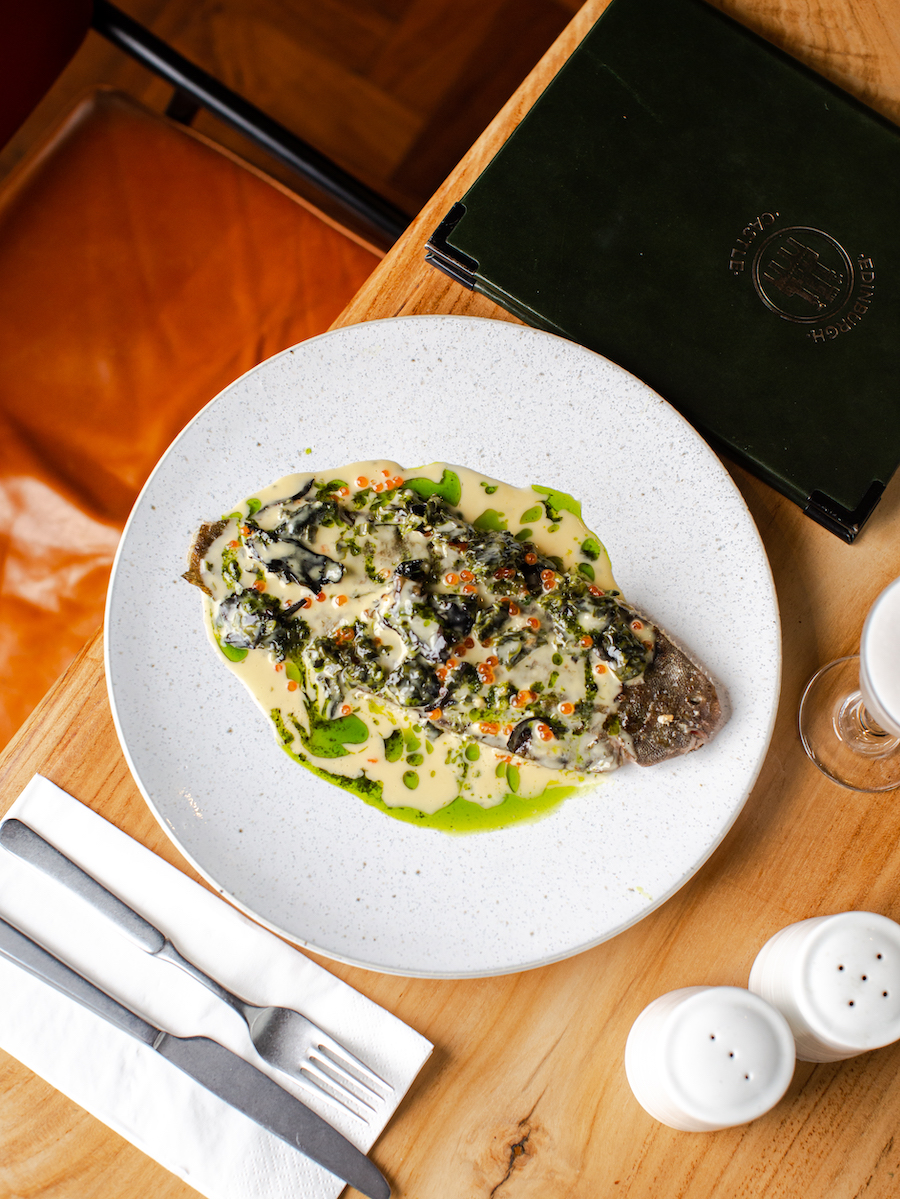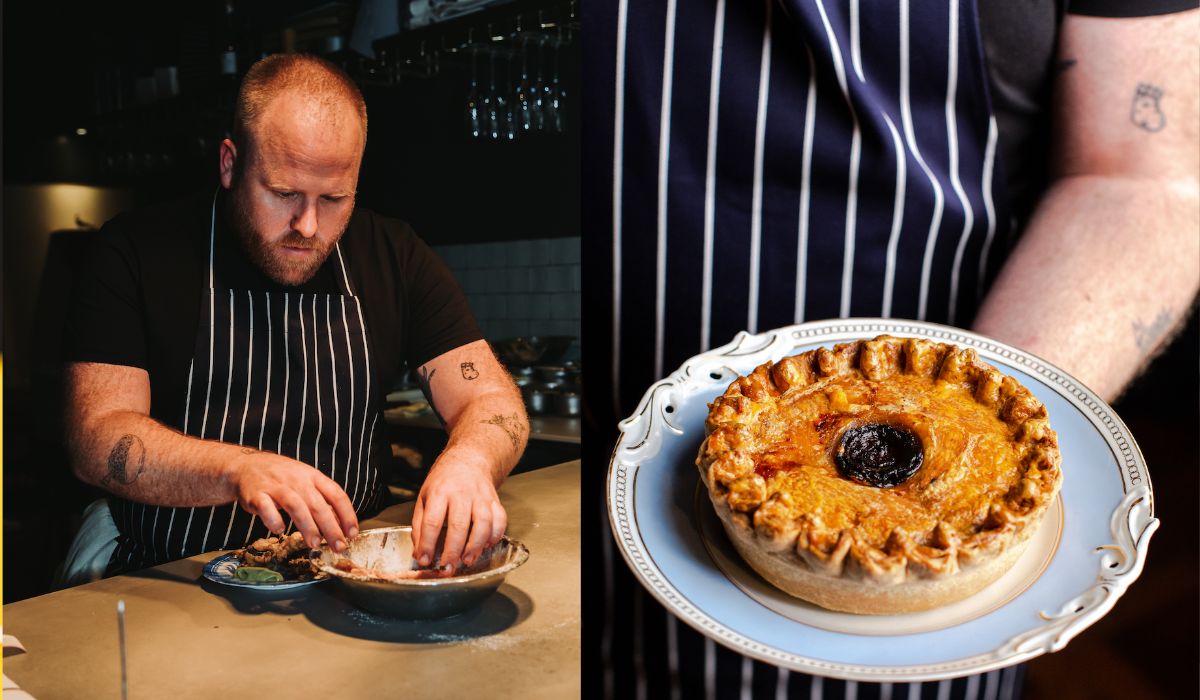Crates of striped spaghetti squash, purple swedes and muddy potatoes are piled up in the corner of the upstairs restaurant at Ancoats’ Edinburgh Castle when I arrive to chat to head chef Shaun Moffat. It looks as if there is a pop up organic farmer’s market on. But these treasures are produce for the kitchen that Shaun has decided to put on display as a visual reminder of the importance of provenance to him and his team.
South Africa born Shaun has only been in Manchester just shy of six months. Previously he worked in London for 14 years. He set up Berber & Q with Josh Katz, the hipsterer than thou East London restaurant serving a mash up of US BBQ meets North African food which Grace Dent described as “almost everything I want from a restaurant”. He did a stint at St Leonard’s with Andrew Clark of Acme Fire Cult (where he also did bits) in London, learning about the importance of putting produce front and centre. Then off to hyper sustainable restaurant The Conduit where the team achieved zero single use plastic and were buying directly from farmers and abattoirs. This was where Shaun developed a real interest in the supply chain. After that he says he was “unofficial” head chef at the nose-to-tail, Italian-inspired Manteca in Shoreditch where they did everything in house from butchery to charcuterie to pasta.

It’s clear that quality produce is this guy’s passion – he even has a tattoo of a potato for god’s sake. Though he says that’s for his son “who looked like a potato – and still looks like a potato”. Among his other tats are a bouquet garni, a pig’s head with a knife through it, and a bowl of Froot Loops.
Toxic masculinity in the kitchen
Tattoos and chefs go together like meat and potatoes but Shaun doesn’t like the negative connotations involved in that whole cliché of debauched, rock n roll chef lifestyles. He thinks it’s a good thing that we are moving away from that. “I’ve never been that masculine chef,” he says, “I’ve always hated those people.” He’s been a victim of the brutality of the kitchen too, telling stories of brandings from a hot knife “for not being on time”.
“There are a lot of problems in the industry and I try my hardest not to be one of them,” he says. “I don’t like to be called chef. I like to go by my name and address all my chefs by their name. I like to know what’s going on with my chefs because we’re all human and the job’s hard enough. So to add more unnecessary, chauvinistic machismo over the whole thing. I think it’s fucking stupid. It doesn’t achieve anything.”

Shaun also wants to champion women. He talks about the love and respect he has for his single mother, and his “powerful” wife and three sisters. He says he is disgusted by how women are often treated in professional kitchens. Statistically women make up less than a quarter of the workforce in kitchens and are paid significantly less than their male counterparts. But Shaun says many of the best chefs he’s worked with are women.
“The real reason the industry is toxic is the amount of white men [in it],” he says, “We’re quite a small team here but we’re hiring [more] women.”
But he talks about his current team at the Edinburgh Castle like a proud dad. Matt Fearnley, previously at Hispi and Aumbrey, is Head Chef, Ollie the pastry chef from Pollen, Georgie Hewitt, also ex-Hispi is Sous Chef, Matt ‘disco’ Turner and his neon crocs completes the kitchen team along with a couple of kitchen porters. He describes them as close-knit.

Jamie Oliver and Fergus Henderson
Shaun’s culinary journey began in his teens with many stoned Friday nights listening to Portishead and cooking Jamie Oliver recipes with mates. Later, he had a big hand in opening one of the first Jamie’s Italians in Bath.
“I will stand by Jamie’s Italian, back in the day,” he says, “It was great. We did all the pasta in house, all the ragus. The amount of chefs my age who are chefs because of The Naked Chef in ’99 is insane.”
“If you look at the chefs who are opening restaurants now, fine dining is kind of dying. It’s not all, ‘if you don’t have a star, you don’t matter’ any more. Which was the case in the late 2000s. If you weren’t doing fine dining, you weren’t a chef. It’s such a shit mentality. But then you like look at the people who are of our age demographic now. You have the Higher Ground/Flawd boys, you have Erst, you have Sparrows you’ve got Top Cuvée in London, you’ve got Pidgin, these places are really casual but just doing amazing food. I think that’s the knock on effect of having this guy [Jamie Oliver] on TV saying ‘It’s just food’.”
The importance of provenance at the Edinburgh Castle
Shaun’s bringing together his two passions – that casual, fun approach coupled with serious attention to provenance – to the slick dining space at The Edinburgh Castle.
“This is the restaurant I’ve wanted to open for a long time. We really try and champion what we’re serving. We list all the farms on our menu where the meat is coming from. If we can, the boat names that the fish is coming off as well. It’s opening that conversation. So many chefs are like: here is meat, cook meat, serve meat. Not everyone looks at it more than that.”

But with better provenance, comes a slightly higher price tag – the kind of thing that puts the wind up some restaurant owners, and some consumers, especially with purse strings so tight right now.
“Yes, it is immediately more expensive but for what you get out of it, it’s worth it. The barn hens you get in Tescos. From hatchling to butchered and sold, I think it’s 31 days. Mental. You look at some chicken bones and [they are] grey. You get a nice corn fed chicken and even from the stock you can see a difference. There’s a lot to be said for sustainability and for buying properly. Obviously it does cost more. It depends on how you divide it I suppose. Me and my wife eat meat once a week. We spend more of our money eating vegetables. We’re an oat milk household.
“My approach to [The Edinburgh Castle] is, it’s a pub. We’re doing really nice food. We’re doing modern techniques behind the food. But we’re still serving pub food.”

Shaun’s dream is to eventually use whole animals to cook ragus, pies, steaks and chops, and make their own charcuterie. Until then, they are taking ‘most of an animal’, focusing on one type at a time. On the day we speak, it’s veal. A rib of veal has been a popular choice with customers at the Edinburgh Castle. I ask if he worries about people’s response to it.
“Old school French veal didn’t even touch the ground, they used to string them up and feed them milk and then kill them,” he says, “That’s a big no – I don’t think it exists any more, actually. Rose veal is an older veal. It’s no longer milk-fed. It’s not a fully fledged cow but it’s part of the cull of the herd. It’s an offshoot of the way farming works. There is a reason behind it, and they only get three or four a year.
“I’d rather take what [my butcher says is] good than what I want. You get so many chefs that have asparagus on the menu all year round, or a pea puree when there are no peas around. Our menu for the past two months has been root vegetables: celeriac, swede, potatoes. There weren’t even parsnips until recently. We use all British produce here. It limits us but gives us creativity. And it means that each week is something new.
British produce rules
“This week, Kale’s coming back. It’s like, yes! Things are green again! Which means asparagus is soon and rhubarb’s starting. It’s great. We could just buy stuff but it doesn’t help any situation. Do you remember when Lost first came out and everyone had to wait a week to watch an episode? It’s kinda like that. It’s exciting. You see that first Instagram post of a wild garlic shoot. Rhubarb, asparagus, all the peas, they have such short seasons so you are continually excited.”

But he’s quick to assure us that he’s not doing it to be “wanky” or “pretentious”.
“It’s not about anyone doing it perfectly,” he says, “It’s about people trying. A lot of people are actively doing it, which is good – and it filters down. Food developers from [supermarkets] go to restaurants all the time to see what people are doing. You can see Wildfarmed flour now in Marks and Spencers. Obviously a good PR move. But one of the biggest nationwide stores using a British wild grain farm flour in their bread? It’s a massive step.
“I’m not British but I love British produce. I’ve been to America. I’ve been to Europe and I’ve been to South Africa. The produce that comes out of England is incredible. As a chef, I’m amazed by it. British food’s incredible as well: pie and mash, fish and chips. It’s all amazing. I love British food.

“I love root vegetables. I love pumpkins. I love asparagus. I love British fruits as well. Oh my god! British strawberries, plums, apricots, gooseberries. We use rapeseed oil here as well because there are no English olives. I genuinely believe British produce is the best in the world. From the fish to the meat to the veg. It’s a hill I will die on.”
There’s no doubt that Shaun is a fan boy of British cooking and culture, he continues waxing lyrical about Scottish halibut and English mackerel and red mullet, cockles and sprats and hare, and a snail farm in Dorset (which makes me pause to contemplate snails with West Country accents). He talks about the revelation that St John maestro Fergus Henderson’s book The Whole Beast: Nose to Tail Eating gave him. A seminal book for so many chefs.

We discuss the current appetite for things like rabbit, snails, and pigs head terrines, a return to centuries old recipes when there was no option to get Peruvian asparagus on the table. Generation convenience has been forced out of that mindset by things like Brexit affecting food chain supplies. But Shaun is one of a new generation of chefs that are being the change they want to see in the world and this ethos is hopefully filtering down into the younger generation.
An ever evolving menu
The menu at the Edinburgh Castle is a concise four snacks, four starters, four mains and four desserts – which Shaun thinks is still quite long. It changes ”almost daily”, dictated by what’s good that week from the fishmongers, butchers and growers they use, and ebbing and flowing based on supply and demand. There is always a pie – recently a Desperate Dan style one with a big hunk of bone marrow sticking out of it got Instagram all hot under the collar. Pearl barley might be draped with vivid green cavolo nero and topped with an egg yolk – when the cavolo season ends, it might be salsify. When asparagus is around, it will go into several dishes. “I don’t care if the same thing is on the menu a thousand times,” Shaun says. He wants to celebrate whatever is basking in the golden hour of its season.

“We’re just trying to make sure that we’re keeping ourselves entertained and cooking things thoughtfully,” he says, “We don’t boil any of our vegetables. We cook them from raw and salt bake them [to achieve the purest taste]. We’re getting great stuff, we don’t fuck around with it too much. People come in and say, this tastes fucking great what have you done to it? Just added a bit of butter and vinegar. If you’re getting [produce that is at] 90%, you only need to do 10% to it, rather than getting something that’s 40% and doing 60% to it.”
He continues, “There is process behind everything but it’s about respecting what we’re doing. There’s no point sourcing like this if you’re going to then bury it under spices or make a celeriac look like a duck or something. It’s celeriac. So why would you paint it any other way?”
That Edinburgh Castle chip butty
Ultimately, The Edinburgh Castle is a good old fashioned British pub and Shaun wants to keep that spirit alive upstairs in the restaurant. Downstairs, there’s a limited bar snacks menu which features pork scratchings, a meat and potato pie, and that chip butty that everyone in Manchester has not stopped talking about for the past three months.

The butty in question was invented as something that would be able to make the journey from the upstairs kitchen to the downstairs pub without coming to too much harm. It features beef fat mayonnaise made from the rendered down offcuts of aged beef fat with tripled cooked chips seasoned with seaweed salt and is served on a pollen potato bun. The upgraded (viral) version has the addition of steak tartare, lubed up with seaweed mayo and topped with an egg yolk. It’s served on a doily for that extra nan-factor.
He sighs somewhat wearily as we talk about it. I ask if it’s his Smells Like Teen Spirit. Has he grown to resent it? He laughs, “I don’t hate it. I don’t. It was just kind of weird. It was a very throwaway thing. It’s just chips and bread.” But like Teen Spirit, sometimes the simplest ideas are the ones that resonate with the most people. When we meet at 3pm on a Wednesday, they have already sold 12 that day. I wonder how many chip butties it takes to go platinum.


